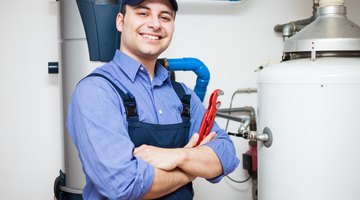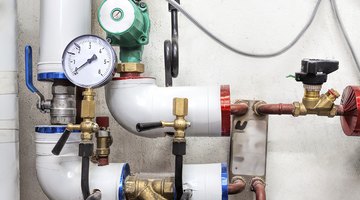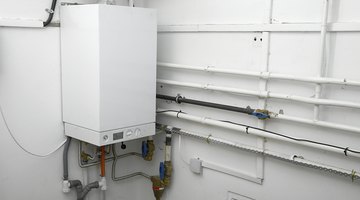How Long Does it Take a Gas Water Heater to Reheat?
Gas water heaters can be an effective means of keeping a home supplied with hot water. The energy costs from electric water heaters can be substantially higher in some areas, and these units are susceptible to power outages, while natural-draft gas water heaters are not.

Calculating how quickly a gas water heater can raise the water’s temperature requires a little bit of math work.
BTU

A British thermal unit (BTU) is the amount of energy needed to raise the temperature of one pound of water by one degree Fahrenheit at normal atmospheric pressure. BTUs are used as an expression of energy consumption for the purpose of comparisons between different fuels.
Tank Size and Thermostat Setting

At 62 degrees Fahrenheit, one gallon of water weighs 8.338 pounds. At this temperature, a 40-gallon water heater would have 333.52 pounds of water. If the water heater used 40,000 BTUs per hour, it would take approximately a half of one minute to raise the temperature in the tank one degree. If the thermostat is set to 122 degrees Fahrenheit, it would take approximately 30 minutes to heat the tank if all heat is transferred to the water.
Tank Efficiency

If the energy efficiency of the water heater is rated at 80 percent, then 20 percent of the heat from the burners is escaping out of the chimney. Therefore, the time to reheat a 40-gallon water heater at 40,000 BTUs is augmented to approximately 36 minutes.
Age of the Water Heater

The effectiveness of the burner can be limited by the condition of the unit and build-up within the tank. If the flame is not as hot due to incorrect air to gas ratios, or there is a build-up of calcium and lime in the tank, the amount of heat that is transferred to the water is reduced, thus increasing the amount of time necessary to heat the water.
The Drip Cap
- Gas water heaters can be an effective means of keeping a home supplied with hot water.
- If the thermostat is set to 122 degrees Fahrenheit, it would take approximately 30 minutes to heat the tank if all heat is transferred to the water.
- If the flame is not as hot due to incorrect air to gas ratios, or there is a build-up of calcium and lime in the tank, the amount of heat that is transferred to the water is reduced, thus increasing the amount of time necessary to heat the water.
Writer Bio
Eric Jonas has been writing in small-business advertising and local community newsletters since 1998. Prior to his writing career, he became a licensed level II gas technician and continues to work in the field, also authoring educational newsletters for others in the business. Jonas is currently a graduate student with a Bachelor of Arts in English and rhetoric from McMaster University.
Photo Credits
- Minerva Studio/iStock/Getty Images
- Minerva Studio/iStock/Getty Images
- KatarzynaBialasiewicz/iStock/Getty Images
- Jupiterimages/liquidlibrary/Getty Images
- KatarzynaBialasiewicz/iStock/Getty Images
- Gudella/iStock/Getty Images
More Articles



